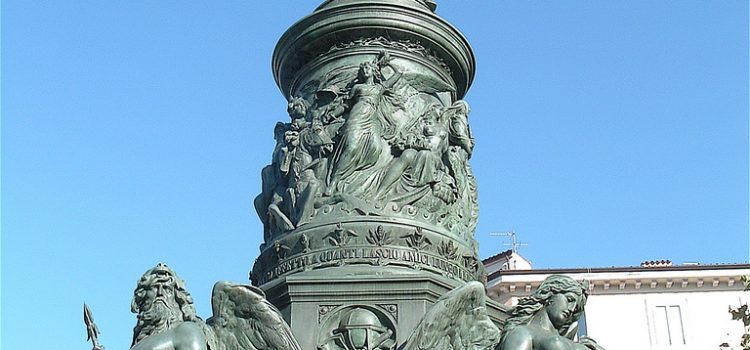La piazza ha origine nel XVIII secolo dai lavori di interramento e sistemazione delle vie prospicienti il mare e affacciate sul Molo Giuseppino, oggi Molo Venezia, sito di attracco, soprattutto, delle navi di proprietà del Lloyd Austriaco fino al XIX secolo.  Piazza Venezia, all’epoca Piazza Giuseppina, era la piazza del Borgo Giuseppino, dal nome dell’imperatore d’Austria Giuseppe II d’Asburgo-Lorena, figlio dell’imperatore Maria Teresa d’Austria e successore nella politica delle riforme avviate dalla madre, tra cui la libertà di culto ai non cattolici e la confisca dei beni degli ordini religiosi contemplativi ceduti successivamente a Napoleonidi e Borboni di Spagna in esilio, a baroni, negozianti e imprenditori della città.
Piazza Venezia, all’epoca Piazza Giuseppina, era la piazza del Borgo Giuseppino, dal nome dell’imperatore d’Austria Giuseppe II d’Asburgo-Lorena, figlio dell’imperatore Maria Teresa d’Austria e successore nella politica delle riforme avviate dalla madre, tra cui la libertà di culto ai non cattolici e la confisca dei beni degli ordini religiosi contemplativi ceduti successivamente a Napoleonidi e Borboni di Spagna in esilio, a baroni, negozianti e imprenditori della città.
Per soddisfare l’esigenze di sviluppo economico e demografico, l’imperatore avviò un’ulteriore espansione della città oltre il Borgo Teresiano (Canal Grande), urbanizzando l’area che si estendeva dalle Mura dell’antica Porta Cavana fino al Lazzaretto San Carlo e dando origine tra il 1788 e il 1825 al Borgo Giuseppino.
Importanti palazzi si affacciano su Piazza Venezia tra cui l’antica dimora del Barone Pasquale Revoltella, sede del Civico Museo Revoltella nonchè le case progettate intorno al 1826-1834 dall’Architetto Valentino Valle e Domenico Corti a cui si deve il merito per la maggior parte della progettazione del quartiere giuseppino.
Al centro della piazza si erge il monumento di Massimiliano, Arciduca d’Austria, realizzato in bronzo dallo scultore Johann Schilling e inaugurato il 3 aprile del 1875 alla presenza dell’Imperatore Francesco Giuseppe. Con 8 metri di altezza, il monumento raffigura Massimiliano in veste da ammiraglio innalzato su un alto tamburo decorato da altorilievi raffiguranti la bandiera austriaca, la bandiera della marina da guerra e mercantile, Trieste e Miramare.
Sulla base ottagonale la riproduzione delle personificazioni a tutta figura dei quattro continenti si alterna alle iscrizioni e ai piccoli medaglioni contenenti i simboli della scienza, della poesia, delle arti e dell’industria. Dopo la prima guerra mondiale e la vittoria degli italiani il monumento venne rimosso e collocato prima in un deposito e dal 1961 nel parco di Miramare, lasciato poi per fare ritorno nel sito originario di piazza Venezia dopo novant’anni d’assenza.





